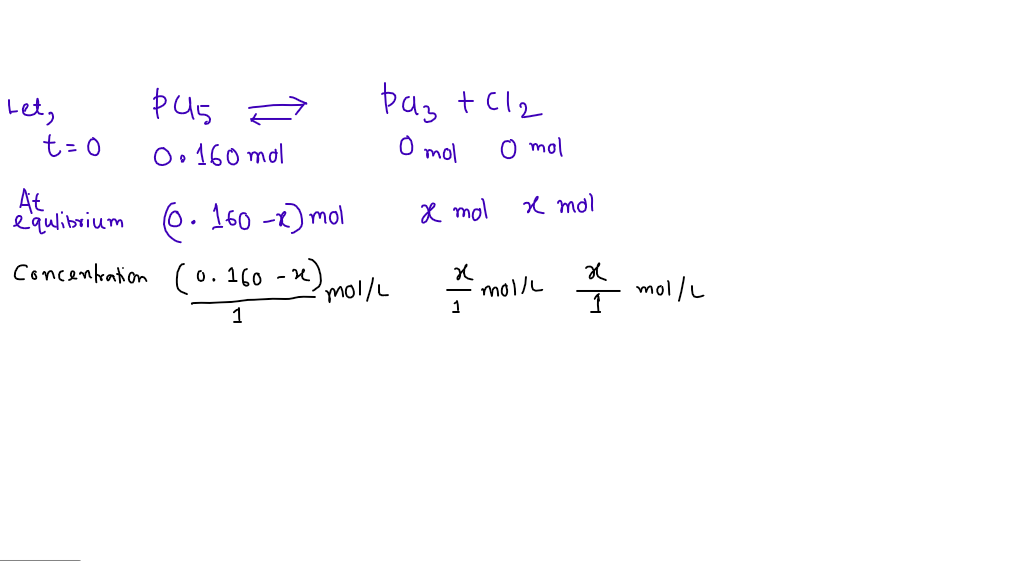A 0.160 mol sample of PCI5(g) is put in a rigid 1.0 L container at an unknown temperature. After a period of time, the system comes to equilibrium. A graph showing the concentration of PCls(g) as a function of time has been plotted below. PCI5(g) = PC13(g) + Cl2(g) 0.160 0.093 [PCI, ] Time a. What was the concentration of PCI5 when the system established equilibrium? b. Find the concentrations of PCI3 and Cl2 at equilibrium. (Hint: Use an ICE chart with the initial and equilibrium concentrations of PCI5). c. On the above graph, sketch curves that show how the concentrations of PC13 and Cl2 change over time. d. Calculate the value of the equilibrium constant K. for the reaction at this temperature Concentration (mol/L)
A 0.160 mol sample of PCI5(g) is put in a rigid 1.0 L container at an unknown temperature. After a period of time, the system comes to equilibrium. A graph showing the concentration of PCls(g) as a function of time has been plotted below. PCI5(g) = PC13(g) + Cl2(g) 0.160 0.093 [PCI, ] Time a. What was the concentration of PCI5 when the system established equilibrium? b. Find the concentrations of PCI3 and Cl2 at equilibrium. (Hint: Use an ICE chart with the initial and equilibrium concentrations of PCI5). c. On the above graph, sketch curves that show how the concentrations of PC13 and Cl2 change over time. d. Calculate the value of the equilibrium constant K. for the reaction at this temperature Concentration (mol/L)
Chemistry
10th Edition
ISBN:9781305957404
Author:Steven S. Zumdahl, Susan A. Zumdahl, Donald J. DeCoste
Publisher:Steven S. Zumdahl, Susan A. Zumdahl, Donald J. DeCoste
Chapter1: Chemical Foundations
Section: Chapter Questions
Problem 1RQ: Define and explain the differences between the following terms. a. law and theory b. theory and...
Related questions
Question
![6) A 0.160 mol sample of PCI5(g) is put in a rigid 1.0 L container at an unknown
temperature. After a period of time, the system comes to equilibrium. A graph
showing the concentration of PCI5(g) as a function of time has been plotted
below.
PCI5(g) = PCI3(8) + Cl2(g)
0.160
0.093
[PCI, ]
Time
a. What was the concentration of PCI5 when the system established
equilibrium?
b. Find the concentrations of PCI3 and Cl2 at equilibrium. (Hint: Use an ICE
chart with the initial and equilibrium concentrations of PCI5).
c. On the above graph, sketch curves that show how the concentrations of
PCI3 and Cl2 change over time.
d. Calculate the value of the equilibrium constant K. for the reaction at this
temperature.
Concentration (mol/L)](/v2/_next/image?url=https%3A%2F%2Fcontent.bartleby.com%2Fqna-images%2Fquestion%2Fd1361fbf-84c1-45c2-a965-6ec81cbd5e5e%2F0ac8346d-8100-45c5-9ed5-46081b9108d4%2Fjutp4ag_processed.png&w=3840&q=75)
Transcribed Image Text:6) A 0.160 mol sample of PCI5(g) is put in a rigid 1.0 L container at an unknown
temperature. After a period of time, the system comes to equilibrium. A graph
showing the concentration of PCI5(g) as a function of time has been plotted
below.
PCI5(g) = PCI3(8) + Cl2(g)
0.160
0.093
[PCI, ]
Time
a. What was the concentration of PCI5 when the system established
equilibrium?
b. Find the concentrations of PCI3 and Cl2 at equilibrium. (Hint: Use an ICE
chart with the initial and equilibrium concentrations of PCI5).
c. On the above graph, sketch curves that show how the concentrations of
PCI3 and Cl2 change over time.
d. Calculate the value of the equilibrium constant K. for the reaction at this
temperature.
Concentration (mol/L)
Expert Solution
Step 1

Trending now
This is a popular solution!
Step by step
Solved in 4 steps with 4 images

Knowledge Booster
Learn more about
Need a deep-dive on the concept behind this application? Look no further. Learn more about this topic, chemistry and related others by exploring similar questions and additional content below.Recommended textbooks for you

Chemistry
Chemistry
ISBN:
9781305957404
Author:
Steven S. Zumdahl, Susan A. Zumdahl, Donald J. DeCoste
Publisher:
Cengage Learning

Chemistry
Chemistry
ISBN:
9781259911156
Author:
Raymond Chang Dr., Jason Overby Professor
Publisher:
McGraw-Hill Education

Principles of Instrumental Analysis
Chemistry
ISBN:
9781305577213
Author:
Douglas A. Skoog, F. James Holler, Stanley R. Crouch
Publisher:
Cengage Learning

Chemistry
Chemistry
ISBN:
9781305957404
Author:
Steven S. Zumdahl, Susan A. Zumdahl, Donald J. DeCoste
Publisher:
Cengage Learning

Chemistry
Chemistry
ISBN:
9781259911156
Author:
Raymond Chang Dr., Jason Overby Professor
Publisher:
McGraw-Hill Education

Principles of Instrumental Analysis
Chemistry
ISBN:
9781305577213
Author:
Douglas A. Skoog, F. James Holler, Stanley R. Crouch
Publisher:
Cengage Learning

Organic Chemistry
Chemistry
ISBN:
9780078021558
Author:
Janice Gorzynski Smith Dr.
Publisher:
McGraw-Hill Education

Chemistry: Principles and Reactions
Chemistry
ISBN:
9781305079373
Author:
William L. Masterton, Cecile N. Hurley
Publisher:
Cengage Learning

Elementary Principles of Chemical Processes, Bind…
Chemistry
ISBN:
9781118431221
Author:
Richard M. Felder, Ronald W. Rousseau, Lisa G. Bullard
Publisher:
WILEY